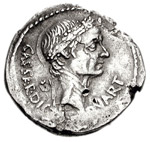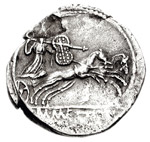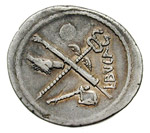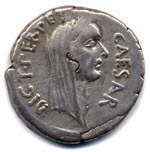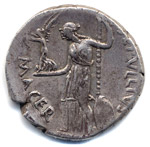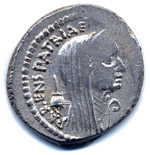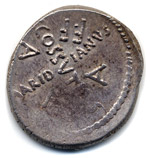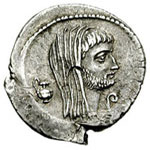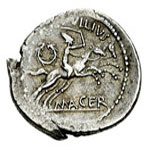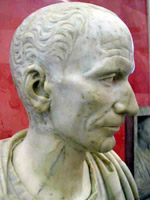A New Honour: The Image of Caesar on Coins
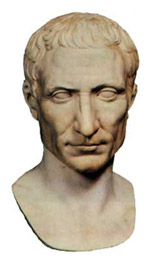
Bust of Caesar
RRC 480/2a © CNG 2006
Obverse: Wreathed head of Caesar right, behind, lituus;
around CAESAR·DICT·QVART. Border of dots.
Reverse: Juno Sospita in a biga right, holding reins
and shield in left hand and spear in right; in exergue, M ·METTIVS.
Border of dots.
RRC 480/6 © CNG 2003
Obverse: Wreathed head of Caesar right; before CAESAR·DICT
downwards; behind, PERPETVO upwards. Border of dots
Reverse: Fasces (without axe) and caduceus
in saltire; on left, axe; on right, globe; above clasped hands; below
L·BVCA. Border of dots.
RRC 480/13
Obverse: Wreathed
head of Caesar right, wearing veil; before CAESAR downwards; behind DICT·PERPETVO
upwards. Border of dots.
Reverse: Venus left, holding victory in right hand and
sceptre in left hand; at bottom of sceptre a shield; behind P·SEPVLLIVS
downwards, before MACER downwards. Border of dots.
RRC 480/19
Obverse: Wreathed head of Caesar right, wearing veil; before, lituus; behind apex; before, CAESAR upwards;
behind, PARENS·PATRIAE upwards. Border of dots.
Reverse: C·COSSVTVIVS and MARIDIANVS arranged in the
form of a cross; in angles A A A FF. Border of dots.
Until Julius Caesar's image appeared on denarii in 44BC (RRC 480/2-21) Roman coins did not carry portraits of living people. There was, however, a long tradition of portraiture whereby a living man could have his image displayed: this is manifested in bronze and marble statues, wax masks, cameos and gems, as well as triumphal paintings. Caesar's lifetime portrait revolutionised the iconography of Roman coins and the purposes for which they could be used.
It is important to note that while Caesar minted many issues in his own name he did not mint any types that featured his own portrait. It is only with the issues of the quattuorviri monetales of 44BC that the portraits appear. While influence by Caesar cannot be ruled out in the decision to use his portrait, his own issues for 44 BC focus on his patron Venus and continued motif of Gallic victories.
Dio Cassius (44.4.4) writes, "In addition to these remarkable privileges they named him father of his country, stamped this title on coinage…" (Loeb translation) Πρός τε τούτοις τοιύτοις οὖσα πατέρα τε αὐτὸν τῆς πατρίδος ἐπωνόμσαν καί ἐς τά νομίσματα ἐνεχάξαϛ This passage refers to the Senate's approval of the use of the honorific title parens patriae (father of his country) on coinage. Historians commonly use it to explain the appearance of Caesar's portrait on coinage. But this passage nowhere states or implies that the Senate voted to allow Caesar's image to accompany the title. The only suggestion of this idea arises from two coins that used Caesar's image with the legend PARENS PATRIAE (RRC 480/19 and 20). While these coins do use both the image of Caesar and the title parens patriae they were most likely minted after the death of Caesar. It remains unclear if the use of his portrait was sanctioned by the state. It is clear, however, that the appearance of Caesar's portrait provided a visual manifestation of the power that Caesar wielded.
While the exact dating of the parens patriae issue is in some doubt, the coins which represented his political offices help to clarify the general chronology of this issue. RRC 480/2 has the obverse legend CAES DICT QVART (fourth Dictatorship). He is known to have still held it until at least 26th January 44 BC as the fasti for this date list his title as dict IIII (dictator for the fourth time). He may even have held the position until the 15th February for Cicero refers to Caesar at the Lupercalia as dictator perpetuus (perpetual dicator) (Cic. Phil 2.87). Thus the introduction of his portrait had occurred by the beginning of February 44 BC. The following issues RRC 480/6-11 (RRC 480/6) with the legend DICT PERPETVO (Dictator for life) are also dated by his office to the final month before his death (15th February to the 15th March 44 BC). The introduction of the veiled head of Caesar into this series, particularly with the legend DICT PERPETVO (RRC 480/12-16, RRC 480/13) is difficult to date. While it has been popular to identify the veil as that of mourning (like that of Antony in RRC 480/22) and thus as a posthumous issue, it is also possible that Caesar is being presented veiled in his capacity as Pontifex Maximus (Morawiecki 1983:23).
The introduction of a portrait coinage has been linked to the belief that Caesar had aspirations to kingship in his final days. The diadem he wears on the coins is not similar to other royal diadems, such as those of the Hellenistic monarchs or those worn by later Roman Emperors, but may rather represent the wreath of the Triumphator (victorious general). Furthermore the portraits of Sulla and Pompey appeared on coinage shortly after their deaths. Carson (1957:52) argued that the appearance of Caesar's portrait during his lifetime represented a natural progression and reflected his unique position rather than any claims to monarchy.
The portraits of Caesar appear in a veristic or natural style. They are believed to closely mirror his actual appearance, especially as they highlight the folds in his neck, his crooked nose and represent his real age (Toynbee 1957:5-6). The images presented in these coins from the final year of his life agree with literary descriptions of Caesar's appearance (Suet. Div. Iul. 45.1-2). We don't know if Caesar himself was used as the model for the image or if recent statues provided an image for the die cutters to reproduce.

